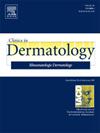通过复原木乃伊指纹鉴定死者身份:调查木乃伊皮纹的法医皮肤学。
IF 2.2
4区 医学
Q2 DERMATOLOGY
引用次数: 0
摘要
指纹是由指尖垫上的隆起和凹陷形成的。每个人都有自己独特的指纹,这些指纹可用于识别生前、死后甚至木乃伊化后的人。木乃伊化可以是自然发生的,也可以是部分木乃伊化(如仅手脚局部木乃伊化)、大面积木乃伊化或完全木乃伊化。皮肤木乃伊化后,可以尝试在指头与手保持完整的情况下采集指纹;但可能需要将指头从手上取下,指垫也可能需要与下层骨骼分离,以确保采集到足够的指纹。通常情况下,木乃伊组织需要重新水化;已经使用了多种溶液来增加指头的张力,使组织软化和柔韧,并增强指垫脊的细节。碳酸钠水溶液(与醋酸混合或与 95% 的乙醇和蒸馏水混合)被认为是最有效的补水方法。之后,可以尝试使用各种技术来获取指纹。其中包括传统的手指涂墨和滚动法,或给手指拍照。可以使用粉末(如铝粉、黑色指纹粉、白色玉米淀粉基粉末或荧光粉)来增强脊纹特征;可以用胶带压住涂有粉末的手指,然后将胶带贴在透明的透明薄片上以保存指纹图案。此外,还可以制作指模(使用模型粘土或硅橡胶)和铸模(使用巴黎石膏、牙科铸造材料或腻子);可以在事先涂抹或不涂抹指纹粉的情况下对指模或铸模或两者进行拍照。在拍摄指尖时,可使用透射光,用光纤光源照亮刮除和去皮指垫的表皮和下层剩余真皮,以显示指脊图案。总之,法医皮肤学在从木乃伊手指上获取指纹方面可以发挥不可或缺的作用,并可成功用于死者身份鉴定。本文章由计算机程序翻译,如有差异,请以英文原文为准。
Identification of decedents by restoring mummified fingerprints: Forensic dermatology in the investigation of mummy dermatoglyphics
Fingerprints are created by elevations and depressions on the fingertip pads. Each person has their own unique fingerprints, which can be used in the identification of that individual when alive, during the immediate postmortem period, or even after the digits have become mummified. Mummification can occur naturally; it can be partial (such as localized to only the hands and feet), extensive, or complete. Obtaining fingerprints after the skin has become mummified can be attempted while the digits remain attached to the hand, but the digits may need to be removed from the hand, and the finger pads may also need to be separated from the underlying bone to secure an adequate fingerprint. The mummified tissue often needs to be rehydrated; numerous solutions have been used that increase the turgor of the digits, provide softening and pliability of the tissue, and enhance the details of the finger pad ridges. An aqueous solution of sodium carbonate (either combined with acetic acid or combined with 95% ethanol and distilled water) was found to be most effective for rehydration. Thereafter, various techniques can be attempted to obtain the fingerprint. These include the traditional method of inking and rolling of the finger or photographing the finger. Powders (such as aluminum powder, black fingerprint powder, white cornstarch-based powder, or fluorescent powder) can be used to enhance the ridge features; adhesive tape can be pressed against the powdered digit and the print pattern preserved by applying the adhesive tape to a clear transparency sheet. Molds (using modeling clay or silicone rubber) and casts (using plaster of paris, dental casting materials, or putty) of the digits can be created; either the molds or the casts or both can be photographed with or without prior application of fingerprint powder. Transillumination, using a fiber optic light source to illuminate the epidermis and underlying remaining dermis of a scraped and defleshed finger pad, can be used to demonstrate the finger ridge pattern when photographing the tip of the digit. Forensic dermatology can play an integral role in obtaining fingerprints from mummified digits, which can be successfully used for the identification of a decedent.
求助全文
通过发布文献求助,成功后即可免费获取论文全文。
去求助
来源期刊

Clinics in dermatology
医学-皮肤病学
CiteScore
4.60
自引率
7.40%
发文量
106
审稿时长
3 days
期刊介绍:
Clinics in Dermatology brings you the most practical and comprehensive information on the treatment and care of skin disorders. Each issue features a Guest Editor and is devoted to a single timely topic relating to clinical dermatology.
Clinics in Dermatology provides information that is...
• Clinically oriented -- from evaluation to treatment, Clinics in Dermatology covers what is most relevant to you in your practice.
• Authoritative -- world-renowned experts in the field assure the high-quality and currency of each issue by reporting on their areas of expertise.
• Well-illustrated -- each issue is complete with photos, drawings and diagrams to illustrate points and demonstrate techniques.
 求助内容:
求助内容: 应助结果提醒方式:
应助结果提醒方式:


